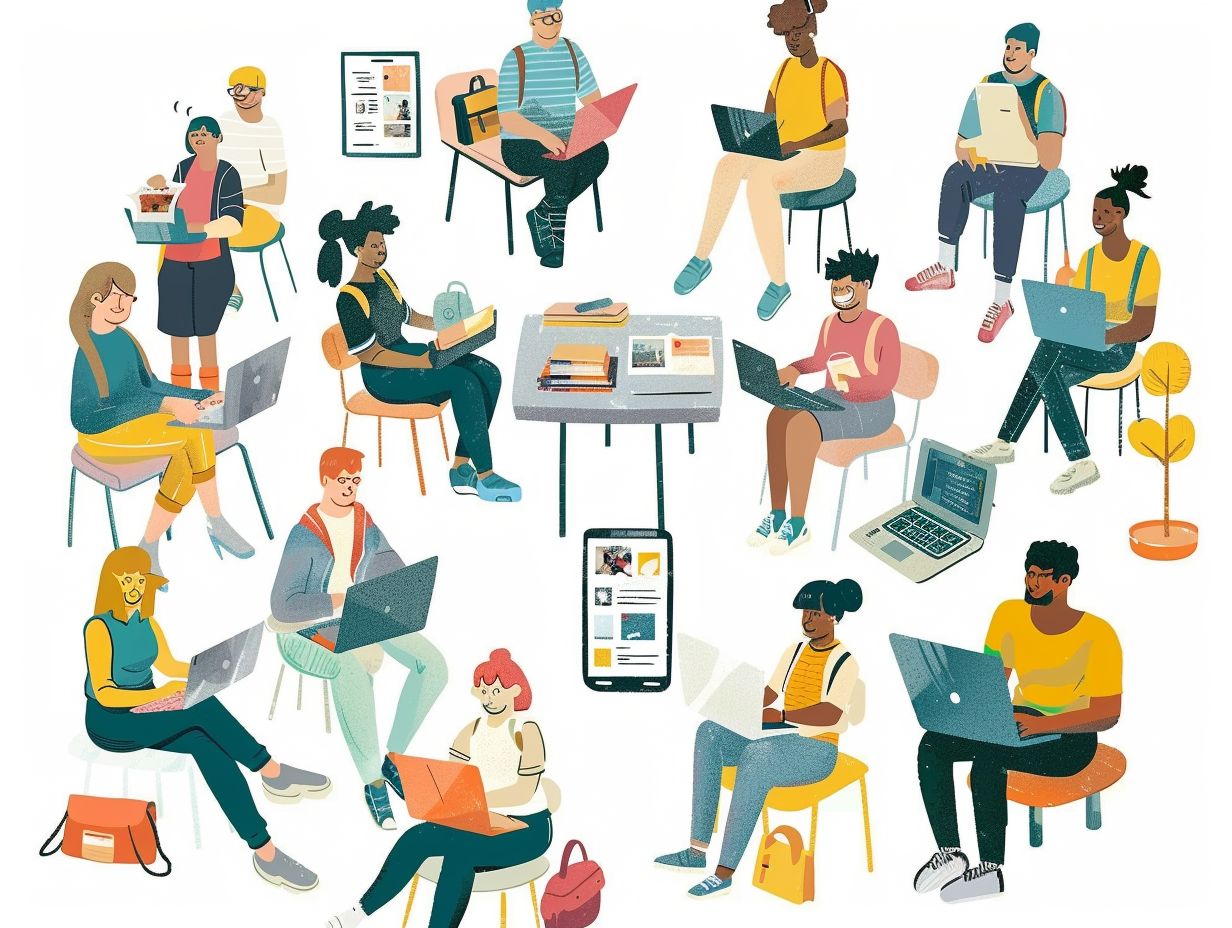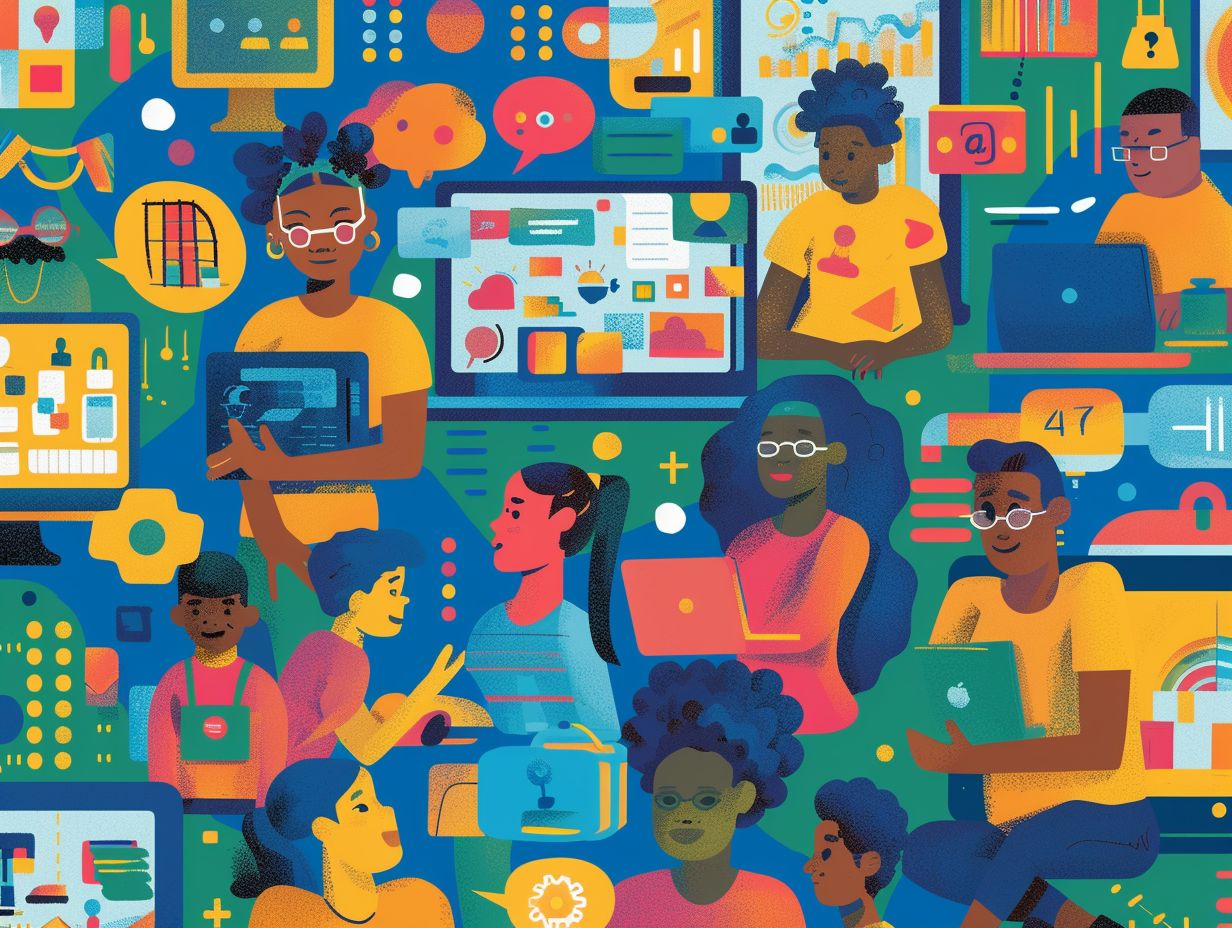In today’s digital age, the divide between those with access to technology and those without is particularly pronounced, especially within the realm of technical e-learning. This article seeks to examine the factors that contribute to this digital gap, the ramifications it has on technical education, and the approaches and resolutions that are being instituted to narrow this divide. Through the exploration of constraints and obstacles, as well as the illustration of triumphant narratives and forthcoming prospects, the article delves into the intricate domain of digital equity within technical e-learning.
Key Takeaways:

- Access to technology and resources is a major factor contributing to the digital divide in technical e-learning.
- Education and training play a crucial role in addressing the digital divide and bridging the gap in technical e-learning.
- Proper strategies and effective solutions are key in successfully addressing the digital divide and ensuring equal opportunities for technical e-learning.
The Digital Divide in Technical E-Learning
The Digital Divide in Technical E-Learning encompasses the discrepancies in access to digital resources and online learning opportunities within the education sector. It sheds light on the obstacles that students encounter in obtaining fair access to technology and navigating the digital landscape in the educational setting. This disparity can have profound effects on students, influencing their capacity to fully engage in contemporary educational methods. Students from underprivileged backgrounds may face challenges in accessing high-speed internet, updated devices, or necessary software, placing them at a considerable disadvantage compared to their peers. Consequently, the educational framework itself may be impacted, with certain student groups finding online learning inaccessible. Addressing digital inequality is imperative to guaranteeing that all students have an equitable chance to excel in the digital era.
Defining the Problem
Understanding the issue of the Digital Divide involves recognizing the discrepancies in digital access faced by students, especially within educational environments. It encompasses the difficulties that stem from insufficient technology resources, limited broadband infrastructure, and the prevailing digital inequality seen among student demographics. The inadequate internet connectivity in underserved regions further amplifies the technology disparities among students. This impedes their ability to fully participate in online learning and access crucial digital resources vital for their academic achievements. Moreover, the steep costs associated with devices and software essential for remote learning create additional burdens for families already grappling with financial limitations. These obstacles obstruct students from acquiring the essential digital skills needed for the contemporary world, perpetuating the cycle of disadvantage and widening the digital access disparity in the realm of education.
Factors Contributing to the Digital Divide
Various elements contribute to the Digital Divide, including challenges in distributing devices, the importance of digital literacy skills, socio-economic barriers affecting technology access, and disparities in wireless broadband service availability. Socio-economic factors significantly influence digital access gaps. Individuals from marginalized communities may encounter financial constraints that impede their ability to afford internet services and devices. Disparities in educational opportunities and access to training programs can shape one’s digital literacy skills, affecting their overall digital proficiency. The distribution of devices plays a critical role in bridging the gap. Unequal access to smartphones, laptops, and other essential equipment can further widen the divide, particularly in remote or underserved areas.
Access to Technology and Resources
Access to Technology and Resources is a critical component in addressing the digital access gap, emphasizing the importance of providing student devices, implementing technology solutions, and enhancing access to digital resources within the education system and learning environments. This access enables you to engage in interactive learning experiences, collaborate on projects, and access a wealth of educational information. By equipping students with the necessary devices and tools, educators can create a more engaging and dynamic learning environment. Technology integration in educational settings also paves the way for personalized learning experiences, adaptive assessments, and the development of digital literacy skills essential for success in the modern world. With the right technological resources at your disposal, you can explore diverse learning opportunities and develop essential 21st-century skills.
Education and Training
 Education and Training play a crucial role in bridging the digital divide by fostering digital literacy skills, enhancing access to digital resources, promoting a secure online environment, and ensuring technology access within the educational setting. By providing individuals with the necessary knowledge and skills to navigate the digital landscape effectively, education and training enable them to engage confidently and securely in online activities. Digital literacy education equips learners with the ability to differentiate between credible information and misleading content, thereby promoting critical thinking and well-considered choices. The integration of technology into educational practices allows students to cultivate essential digital competencies that are increasingly valuable in today’s technology-driven world. Through education, individuals are better equipped to leverage the benefits of digital tools while also understanding the importance of online safety.
Education and Training play a crucial role in bridging the digital divide by fostering digital literacy skills, enhancing access to digital resources, promoting a secure online environment, and ensuring technology access within the educational setting. By providing individuals with the necessary knowledge and skills to navigate the digital landscape effectively, education and training enable them to engage confidently and securely in online activities. Digital literacy education equips learners with the ability to differentiate between credible information and misleading content, thereby promoting critical thinking and well-considered choices. The integration of technology into educational practices allows students to cultivate essential digital competencies that are increasingly valuable in today’s technology-driven world. Through education, individuals are better equipped to leverage the benefits of digital tools while also understanding the importance of online safety.
Impacts of the Digital Divide on Technical E-Learning
The impacts of the Digital Divide on Technical E-Learning extend to equity measures within the education sector, influencing the educational structure, shaping learning environments, and exacerbating digital disparities among student populations. This digital gap not only affects your access to online resources but also impacts your ability to participate fully in digital learning opportunities. The unequal distribution of technology resources hinders students from marginalized backgrounds, widening the gap in educational outcomes. The lack of access to reliable internet connectivity and proper devices can limit your engagement with e-learning platforms, hindering your academic progress. As a result, the digital divide can perpetuate socioeconomic disparities and inhibit the development of a level playing field in education.
Limitations and Challenges
Limitations and challenges stemming from the digital divide in technical e-learning include issues such as insufficient device connectivity, restricted educational opportunities, barriers to digital inclusion, and the evolving trends in digital divide dynamics. Limited access to high-speed internet and lack of proper devices hinder students’ ability to fully engage in online coursework, leading to disparities in learning outcomes. The unequal distribution of resources exacerbates the gap, especially in marginalized communities where access to technology is scarce. As technology advances at a rapid pace, the divide widens as individuals struggle to keep up with the latest tools and software required for effective e-learning. This disparity not only affects individual progress but also impacts overall societal development and economic growth.
Addressing the Digital Divide
Addressing the Digital Divide requires collaborative efforts through community partnerships to enhance technology access, expand educational opportunities, and provide digital resources that promote equitable access to learning. This necessitates a multi-faceted approach that involves engaging local organizations, businesses, and government agencies to pool resources and expertise. By fostering strong relationships with these key stakeholders, individuals and communities can gain broader access to technology training programs, internet connectivity, and digital tools. Leveraging mobile technologies and online platforms can facilitate the delivery of educational content in remote or underserved areas, creating a more inclusive learning environment. Through strategic planning and effective implementation, bridging the digital divide becomes a tangible goal achievable through collective action.
Strategies for Bridging the Gap
Strategies for Bridging the Gap in the digital access divide involve implementing technology solutions, fostering equitable access within the education sector, and enableing students with the necessary resources to overcome digital disparities. One effective approach is to establish partnerships between tech companies and educational institutions to provide students with access to necessary hardware and software. Targeted initiatives should be developed to reach marginalized communities and address their specific needs. Training programs for teachers and students on digital literacy can also play a crucial role in narrowing the digital divide. Creating affordable internet packages and distributing devices to underserved areas can greatly enhance connectivity. These multifaceted strategies aim to create a more inclusive digital learning environment for all.
Success Stories and Case Studies
 Success Stories and Case Studies illustrate initiatives such as those undertaken by Summit Public Schools and Education Superhighway, demonstrating efforts towards digital inclusion and providing wireless broadband service to bridge the digital access gap. For example, Summit Public Schools in California implemented a comprehensive digital learning program, ensuring that all students have access to essential online resources. By distributing Chromebooks to every student and collaborating closely with Education Superhighway, they were able to significantly reduce the digital divide. Education Superhighway, on the other hand, has played a crucial role in advocating for enhanced internet infrastructure in schools across the country. Through partnerships with various stakeholders and policymakers, they have effectively upgraded connectivity in thousands of schools, positively impacting students’ educational outcomes.
Success Stories and Case Studies illustrate initiatives such as those undertaken by Summit Public Schools and Education Superhighway, demonstrating efforts towards digital inclusion and providing wireless broadband service to bridge the digital access gap. For example, Summit Public Schools in California implemented a comprehensive digital learning program, ensuring that all students have access to essential online resources. By distributing Chromebooks to every student and collaborating closely with Education Superhighway, they were able to significantly reduce the digital divide. Education Superhighway, on the other hand, has played a crucial role in advocating for enhanced internet infrastructure in schools across the country. Through partnerships with various stakeholders and policymakers, they have effectively upgraded connectivity in thousands of schools, positively impacting students’ educational outcomes.
Examples of Effective Solutions
Effective solutions for bridging the digital divide include deploying remote access technology, utilizing digital resources to broaden educational opportunities, and implementing technology solutions that improve digital access for students. When you employ remote access technology, students are able to connect to virtual learning environments and access educational content from any location, enabling flexible and uninterrupted learning experiences. The incorporation of digital resources like online libraries, interactive tools, and multimedia content enhances the educational journey by offering a variety of learning materials. Innovative technology solutions such as adaptive learning platforms and personalized feedback systems also play a role in enhancing digital access and student engagement in technical e-learning environments.
Future Outlook and Potential Solutions
The future outlook and potential solutions for the digital divide involve advancements in wireless broadband service, addressing socio-economic barriers that impact technology access, and fostering educational health and citizenship through enhanced digital inclusion efforts. Wireless broadband advancements have the potential to bridge the gap in terms of internet access, particularly in underserved rural areas where connectivity remains a challenge. By expanding wireless networks and enhancing internet infrastructure, more individuals can benefit from online learning opportunities. Initiatives that focus on providing affordable devices and internet plans can help alleviate the socio-economic challenges that often impede access to technology. Promoting digital literacy and citizenship through educational programs can enable individuals to navigate the digital landscape effectively, ensuring they can fully participate in the digital economy.
Technological Advancements and Opportunities
In addressing the digital divide, you can leverage technological advancements and opportunities such as initiatives like Universal Connectivity and tools like Splashtop. These responses are crucial in bridging the gap in digital access by offering innovative solutions and equipping individuals and communities with essential tools. The Universal Connectivity initiative strives to establish a world where everyone has access to affordable internet, enableing them with knowledge and opportunities. Tools like Splashtop facilitate smooth remote access, allowing students, workers, and businesses to remain connected and productive. The challenges posed by events like the Covid-19 pandemic have underscored the critical need to tackle digital disparities promptly. This urgency has prompted organizations and governments to expedite efforts in promoting digital inclusion and ensuring that no one is left behind in this digital age.
Frequently Asked Questions
What is the digital divide in technical e-learning?
 The digital divide in technical e-learning refers to the gap between those who have access to and can effectively use digital technologies and those who do not, particularly in the context of technical or STEM education.
The digital divide in technical e-learning refers to the gap between those who have access to and can effectively use digital technologies and those who do not, particularly in the context of technical or STEM education.
Why is addressing the digital divide important in technical e-learning?
Addressing the digital divide is important in technical e-learning because it ensures that all students have equal opportunities to gain the necessary skills and knowledge in order to succeed in the digital age.
What are some ways to address the digital divide in technical e-learning?
Some ways to address the digital divide in technical e-learning include providing access to technology and internet resources, offering digital literacy training, and implementing inclusive and accessible teaching methods.
How does the digital divide impact students’ learning in technical e-learning?
The digital divide can negatively impact students’ learning in technical e-learning by limiting their access to resources, hindering their ability to fully participate in online activities, and creating unequal learning opportunities.
What are some potential solutions to bridge the digital divide in technical e-learning?
Potential solutions to bridge the digital divide in technical e-learning include providing low-cost or free technology resources, offering flexible learning options, and partnering with organizations to provide access to technology and internet services.
How can educators ensure that all students have equal opportunities in technical e-learning?
Educators can ensure equal opportunities in technical e-learning by acknowledging and addressing the digital divide, providing accommodations for students with limited access to technology, and promoting inclusive and accessible teaching practices.
